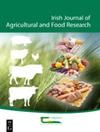The interactive effects of various nitrogen fertiliser formulations applied to urine patches on nitrous oxide emissions in grassland
IF 1.4
4区 农林科学
Q3 AGRICULTURE, MULTIDISCIPLINARY
引用次数: 13
Abstract
Abstract Pasture-based livestock agriculture is a major source of greenhouse gas (GHG) nitrous oxide (N2O). Although a body of research is available on the effect of urine patch N or fertiliser N on N2O emissions, limited data is available on the effect of fertiliser N applied to patches of urinary N, which can cover up to a fifth of the yearly grazed area. This study investigated whether the sum of N2O emissions from urine and a range of N fertilisers, calcium ammonium nitrate (CAN) or urea ± urease inhibitor ± nitrification inhibitor, applied alone (disaggregated and re-aggregated) approximated the N2O emission of urine and fertiliser N applied together (aggregated). Application of fertiliser to urine patches did not significantly increase either the cumulative yearly N2O emissions or the N2O emission factor in comparison to urine and fertiliser applied separately with the emissions re-aggregated. However, there was a consistent trend for approximately 20% underestimation of N2O loss generated from fertiliser and urine applied separately when compared to figures generated when urine and fertiliser were applied together. N2O emission factors from fertilisers were 0.02%, 0.06%, 0.17% and 0.25% from urea ± dicyandiamide (DCD), urea + N-(n-butyl) thiophosphoric triamide (NBPT) + DCD, urea + NBPT and urea, respectively, while the emission factor for urine alone was 0.33%. Calcium ammonium nitrate and urea did not interact differently with urine even when the urea included DCD. N2O losses could be reduced by switching from CAN to urea-based fertilisers.不同氮肥配方对草地氮氧化物排放的交互作用
摘要牧场畜牧业是温室气体(GHG)一氧化二氮(N2O)的主要来源。尽管有大量关于尿氮或肥料氮对N2O排放的影响的研究,但关于肥料氮对尿氮斑块的影响的数据有限,尿氮斑块可以覆盖每年五分之一的放牧面积。本研究调查了尿液和一系列氮肥(硝酸钙铵(CAN)或尿素±脲酶抑制剂±硝化抑制剂,单独施用(分解和重新聚集)的N2O排放量总和是否接近尿液和化肥N一起施用(聚集)的N2 O排放量。与单独施用尿液和肥料并重新聚集排放物相比,在尿液贴片上施用化肥并没有显著增加年累计N2O排放量或N2O排放系数。然而,与同时施用肥料和尿液时产生的数字相比,单独施用化肥和尿液产生的N2O损失被低估了约20%,这是一个一致的趋势。尿素±双氰胺(DCD)、尿素+N-(正丁基)硫代磷酸三胺(NBPT)+DCD、尿素+NBPT和尿素的N2O排放因子分别为0.02%、0.06%、0.17%和0.25%,而单独尿液的排放因子为0.33%。即使尿素中含有DCD,硝酸铵钙和尿素与尿液的相互作用也没有不同。从CAN转向尿素肥料可以减少N2O的损失。
本文章由计算机程序翻译,如有差异,请以英文原文为准。
求助全文
约1分钟内获得全文
求助全文
来源期刊
CiteScore
2.50
自引率
20.00%
发文量
23
审稿时长
>36 weeks
期刊介绍:
The Irish Journal of Agricultural and Food Research is a peer reviewed open access scientific journal published by Teagasc (Agriculture and Food Development Authority, Ireland). Manuscripts on any aspect of research of direct relevance to Irish agriculture and food production, including plant and animal sciences, food science, agri environmental science, soils, engineering, buildings, economics and sociology, will be considered for publication. The work must demonstrate novelty and relevance to the field of research. Papers published or offered for publication elsewhere will not be considered, but the publication of an abstract does not preclude the publication of the full paper in this journal.

 求助内容:
求助内容: 应助结果提醒方式:
应助结果提醒方式:


